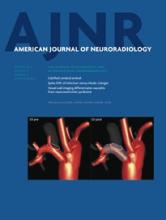Abstract
BACKGROUND AND PURPOSE: FLAIR-hyperintense vessels are known to be a sign of sluggish collateral blood flow in hemispheric vessel occlusion. Additionally, they seem to have a prognostic implication. The aim of the current study was to evaluate the hyperintense configuration of the basilar artery (FLAIR-hyperintense basilar artery) as a marker of basilar artery occlusion and as a predictor of patient outcome.
MATERIALS AND METHODS: We retrospectively identified 20 patients with basilar artery occlusion who initially underwent MR imaging with subsequent DSA. The diagnostic accuracy of the FLAIR-hyperintense basilar artery sign was tested by 4 independent readers in a case-control design, and the relation among FLAIR-hyperintense basilar artery and DWI posterior circulation–ASPECTS, patient outcome, and patient survival was evaluated. To grade the extent of the FLAIR-hyperintense basilar artery sign, we generated a score by counting the number of sections from the basilar tip to the foramen magnum in which a hyperintense signal in the vessel lumen was present multiplied by the section thickness.
RESULTS: The FLAIR-hyperintense basilar artery sign showed moderate sensitivity (65%–95%) but very good specificity (95%–100%) and accuracy (85%–93%) for the detection of basilar artery occlusion. Substantial or excellent inter-reader agreement was observed (Cohen κ, 0.64–0.85). The FLAIR-hyperintense basilar artery inversely correlated with the posterior circulation–ASPECTS (r = −0.67, P = .01). Higher FLAIR-hyperintense basilar artery scores were associated with patient death (28.3 ± 13.7 versus 13.4 ± 11.1, P < .05).
CONCLUSIONS: The FLAIR-hyperintense basilar artery sign proved to be a valuable marker of vessel occlusion and may substantially support the diagnosis of basilar artery occlusion. The established FLAIR-hyperintense basilar artery score may be helpful for the prediction of individual patient survival.
ABBREVIATIONS:
- BAO
- basilar artery occlusion
- FHBA
- FLAIR-hyperintense basilar artery
- FHV
- FLAIR-hyperintense vessel
- pc-ASPECTS
- posterior circulation–ASPECTS
- © 2014 by American Journal of Neuroradiology












